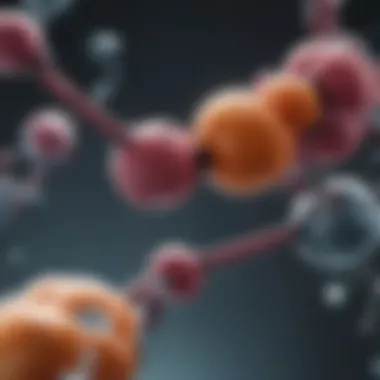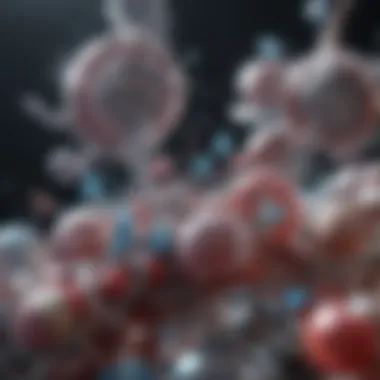Anti-Androgen Drugs: Mechanisms, Indications, and Side Effects


Intro
Anti-androgen drugs play a crucial role in modern medicine, particularly pertaining to hormone-related disorders and specific cancers such as prostate cancer. These drugs act by inhibiting the effects of androgens, which are hormones that can influence various biological functions, including growth and development of certain tissues. Their significance cannot be overstated as they offer therapeutic strategies that cater to a variety of medical conditions. This comprehensive overview seeks to dissect the complexities of these medications, shedding light on their mechanisms, therapeutic usage, and potential side effects.
Research Overview
Methodological Approaches
Understanding and analyzing the effectiveness of anti-androgen drugs necessitates rigorous methodological approaches. Clinical trials often serve as the gold standard for evaluating the efficacy and safety of these medications. Researchers design studies that typically randomize participants to either treatment or control groups. Such designs help mitigate biases and ascertain clear responses to anti-androgen therapy. Additionally, observational studies contribute valuable data on long-term outcomes and real-world effectiveness over time.
Significance and Implications
The implications of anti-androgen therapies extend beyond immediate clinical settings. Their usage can lead to a paradigm shift in treating not only prostate cancer but also conditions such as polycystic ovary syndrome and hirsutism. Optimizing treatment regimens can significantly impact patient quality of life, and ongoing research continues to uncover new potential applications of these drugs. This ongoing exploration holds promise for developing personalized medicine strategies where hormonal influences are managed more effectively.
Current Trends in Science
Innovative Techniques and Tools
Today’s scientific advancements have introduced innovative techniques that enhance the understanding of anti-androgen drugs. Techniques such as high-throughput screening allow researchers to quickly assess the potential of different compounds. Furthermore, advanced imaging technologies and biomarker identification provide deeper insights into how these drugs interact within biological systems.
Interdisciplinary Connections
The field of anti-androgen research benefits from interdisciplinary collaboration. Input from pharmacology, biochemistry, and even genetics converge to create a more holistic understanding. Such interdisciplinary connections are evident in studies that analyze genetic predispositions to hormone-driven diseases, allowing for better-targeted therapeutic approaches.
"A robust understanding of anti-androgen drugs aids in comprehending their broad implications in both clinical and research settings."
The exploration of anti-androgen drugs is a multifaceted endeavor that requires a cohesive understanding of their mechanisms, applications, and the contemporary scientific landscape. This detailed examination aims to engage students, researchers, educators, and professionals, making it an essential resource for all stakeholders involved in hormone-related therapies.
Preamble to Anti-Androgens
Anti-androgen drugs are significant in the realm of modern medicine. These medications specifically target androgen hormones, such as testosterone, inhibiting their effects in the body. This action proves essential in managing various conditions, particularly those related to hormonal imbalances. By understanding how these drugs function and their application, we can appreciate their value in treating diseases like prostate cancer, acne, and hirsutism.
Definition and Role
Anti-androgens are substances that block the action of androgens, which are hormones that contribute to masculine traits and reproductive activity. Androgens, including testosterone and dihydrotestosterone, are crucial in several biological processes; however, in certain conditions, their excessive activity can lead to unwanted effects. Anti-androgens play a pivotal role in medical treatment by mitigating these adverse impacts. They work primarily by binding to androgen receptors, preventing androgens from exerting their effects on target tissues. Various conditions, including hormone-sensitive cancers, benefit greatly from this class of drugs.
Historical Context
The development of anti-androgen drugs has evolved considerably over time. Initially, attention to these compounds grew in the mid-20th century as researchers sought ways to manage hormone-responsive diseases. The first non-steroidal anti-androgen, Flutamide, was introduced in the late 1980s, targeting prostate cancer effectively. This marked a turning point, not only for cancer treatment but also for conditions like hirsutism and severe acne. Since then, the classification has expanded, leading to the development of multiple generations of anti-androgens, with ongoing research aimed at discovering innovative treatments. Each step in this evolution sheds light on the increasing understanding of hormonal interactions in human health.
Mechanisms of Action
Understanding the mechanisms of action of anti-androgen drugs is essential for appreciating their role in modern medicine. These mechanisms elucidate how these drugs interfere with androgen activity, providing foundational knowledge for their therapeutic applications. By exploring the specific elements involved, benefits, and considerations, one can comprehend how anti-androgens manage hormone-related disorders effectively.
Androgen Receptor Inhibition
Androgen receptor inhibition is one of the primary mechanisms through which anti-androgen drugs exert their effects. The androgen receptor is a type of nuclear receptor that is activated by binding to androgens, such as testosterone and dihydrotestosterone (DHT). Once activated, these receptors facilitate changes in gene expression that can lead to a variety of physiological responses, including the promotion of prostate cancer cell growth.
Anti-androgens like flutamide and enzalutamide disrupt this process by binding to the androgen receptor without activating it. This blockade prevents androgens from exerting their biological effects on target tissues. The importance of this inhibition cannot be overstated, especially in the realm of prostate cancer treatment. By preventing androgens from stimulating cancer cell growth, these drugs can significantly slow disease progression and improve patient outcomes.


Alteration of Hormonal Pathways
The alteration of hormonal pathways is another critical mechanism involving anti-androgens. These drugs can influence hormone levels beyond just receptor interaction. For example, spironolactone works not only as an androgen receptor antagonist but also as a diuretic that affects mineralocorticoid receptors. This multifaceted approach allows for the management of conditions such as hirsutism and acne in women, where androgens play a crucial role.
Additionally, altering hormonal pathways may involve downregulating the synthesis of sex hormones or changing the conversion processes in the body. Cyproterone acetate exemplifies this, as it inhibits the effects of androgens while also decreasing testosterone production. Such dual action is advantageous in treating endocrine disorders and can mitigate side effects, offering a comprehensive approach to hormone management.
"The intricate interactions of anti-androgens within hormonal pathways highlight their significance in targeting disorders linked to androgen overactivity."
Classification of Anti-Androgen Drugs
The classification of anti-androgen drugs is a significant aspect of understanding how these medications function and their applications. This categorization not only helps in identifying their mechanisms but also guides clinicians in selecting the most appropriate treatment options based on individual patient needs. Anti-androgens are primarily divided into two main categories: steroidal and non-steroidal anti-androgens. Each class has unique properties, uses, and implications in clinical practice.
Steroidal Anti-Androgens
Steroidal anti-androgens are synthetic analogs of steroid hormones. They primarily function by interfering with androgen receptors. One notable example in this category is Cyproterone Acetate. This drug is often used in managing conditions like hirsutism and severe acne, especially among women. It works by blocking the actions of testosterone and other androgens that can exacerbate these conditions.
Another example is Spironolactone. While primarily a diuretic, it has notable anti-androgenic properties that make it effective in treating hyperaldosteronism and managing acne. Importantly, steroidal anti-androgens also demonstrate some degree of hormonal activity, influencing various pathways in the body.
Non-Steroidal Anti-Androgens
Non-steroidal anti-androgens represent a newer class of drugs. They are designed to selectively bind to androgen receptors without exhibiting steroid-like hormonal activity. Flutamide is one of the earliest non-steroidal anti-androgens used mainly in treating prostate cancer. It directly inhibits androgen receptor function, thus preventing testosterone from exerting its effects.
Other notable examples include Bicalutamide and Enzalutamide. Bicalutamide is frequently prescribed for prostate cancer patients and is appreciated for its ability to enhance patient outcomes without significant hormonal side effects. Enzalutamide, on the other hand, is a more advanced anti-androgen that offers benefits even in cases where other therapies have failed. Its use is increasing in clinical settings, marking a shift in how prostate cancer is managed.
Non-steroidal anti-androgens are preferred in many settings due to their targeted action and lower chances of systemic effects compared to steroidal variants.
In summary, the classification of anti-androgen drugs into steroidal and non-steroidal categories sharpens our understanding of their distinct uses and mechanisms. This distinction is crucial for medical professionals as it aids in therapeutic decision-making, accommodating patient-specific needs, and optimizing treatment efficacy.
List of Common Anti-Androgen Drugs
The landscape of anti-androgen drugs is diverse, featuring several critical medications that play a significant role in clinical practices. Understanding the common anti-androgen drugs is essential for grasping how they bridge different therapeutic approaches. This section dives into specific drugs, their mechanisms, and their clinical implications.
Spironolactone
Spironolactone is a potassium-sparing diuretic that also acts as an anti-androgen. It primarily antagonizes the androgen receptor, effectively blocking the effects of male hormones. This drug is frequently used in treating conditions like acne and hirsutism, especially in women. Its ability to decrease androgen levels contributes to making the skin clearer and less oily. Moreover, spironolactone is also significant in managing blood pressure and heart failure due to its diuretic properties.
Flutamide
Flutamide works specifically as a non-steroidal anti-androgen. It is predominantly prescribed for the management of prostate cancer. Its mechanism involves blockade of the androgen receptors, thus inhibiting the growth of cancer cells fueled by androgen hormones. Patients often receive flutamide as part of a combination therapy, enhancing the overall effectiveness of anti-cancer strategies. However, careful monitoring for liver function is crucial due to the potential for hepatotoxicity.
Bicalutamide
Bicalutamide is one more widely used non-steroidal anti-androgen, particularly in the treatment of advanced prostate cancer. It functions similarly to flutamide by binding to androgen receptors, thus preventing testosterone from exerting its effects. Bicalutamide is often well-tolerated, and its side effect profile is related to hormonal adjustments, including potential gynecomastia. It's notable that bicalutamide may be administered as part of a first-line approach or alongside surgical interventions like orchiectomy.
Enzalutamide
Enzalutamide represents a new generation of anti-androgens designed to target prostate cancer resistant to other treatments. It offers multi-faceted mechanisms, not only blocking androgen receptor activities but also inhibiting their nuclear translocation. This results in decreased cancer cell proliferation and survival. Clinical trials show that enzalutamide significantly improves survival rates in patients with metastatic castration-resistant prostate cancer. This drug has reshaped the treatment landscape and is an important topic in ongoing prostate cancer research.
Cyproterone Acetate
Cyproterone Acetate combines anti-androgenic activity with progestogenic properties. It is frequently utilized in treating conditions like severe acne, hirsutism, and as part of hormone therapy for transgender individuals. By reducing the effect of androgens, cyproterone provides a dual benefit when combined with other hormones. However, its use requires careful attention due to potential side effects including mood changes and liver issues.


Understanding these common anti-androgen drugs—like spironolactone, flutamide, bicalutamide, enzalutamide, and cyproterone acetate—is fundamental for both clinical practice and patient management in endocrinology and oncology. Those seeking to enhance their knowledge on treatment options should consider the details provided in this section as essential learning.
Indications for Use
The use of anti-androgen drugs encompasses various medical conditions. Understanding these indications is essential for medical professionals, patients, and researchers. Anti-androgens help manage hormonal imbalances and treat specific cancers effectively. Their applications span across several conditions, making them vital in therapeutic strategies.
Treatment of Prostate Cancer
Prostate cancer is one of the leading cancers among men. Anti-androgen drugs play a crucial role in the management of this disease. Medications like Bicalutamide and Enzalutamide are commonly prescribed to suppress testosterone, which fuels prostate cancer growth. The therapy often begins when the cancer is diagnosed, particularly if it is advanced, or in combination with other treatments like surgery or radiation.
The aim is to slow down disease progression and to improve survival rates. As with any cancer therapy, the choice of drug must be carefully considered based on the patient's condition and responses to previous treatments.
"Anti-androgens provide an invaluable option for prostate cancer patients, particularly in advanced stages."
Management of Acne and Hirsutism
Acne and hirsutism are two common conditions associated with hormonal disturbances, especially in women. Anti-androgens, such as Spironolactone, are used to manage these conditions effectively. They work by reducing the levels of androgens that can contribute to increased sebum production in acne. For hirsutism, anti-androgens help decrease the excessive hair growth caused by elevated androgen levels.
The treatment often leads to significant improvements in skin condition and hair growth patterns, enhancing the quality of life for many individuals. Patients should be aware of continued monitoring and potential side effects during this management.
Endocrine Disorders
Hormonal disorders can disrupt normal bodily functions. Anti-androgens are often employed in the treatment of conditions such as polycystic ovary syndrome (PCOS) and certain adrenal disorders. In PCOS, elevated androgen levels can lead to symptoms like irregular periods and fertility issues. Cyproterone Acetate is one example that can be effectively used in these cases.
The safety profiles of anti-androgens make them suitable for long-term management in certain disorders. However, understanding individual responses and potential side effects remains an overarching priority for treatment success.
In summary, anti-androgen drugs are used across a broad spectrum of medical conditions, focusing on balancing hormonal levels to improve patient outcomes. Professionals must continue to assess the benefits and limitations of these treatments as they evolve.
Potential Side Effects
Understanding the potential side effects of anti-androgen drugs is crucial for informed usage as well as for guiding treatment decisions. These medications, while effective in mitigating the effects of androgens, can produce a variety of adverse reactions that may influence patient compliance and overall health outcomes. Being aware of these effects allows healthcare providers to make better choices in monitoring and adjusting treatment plans for individual patients.
Anti-androgen drugs, though they serve significant roles in managing conditions such as hormone-related disorders and certain types of cancers, come with a spectrum of potential side effects that must be discussed thoroughly with patients before beginning therapy.
Common Adverse Reactions
Several common adverse reactions can occur in patients taking anti-androgen drugs. These may include:
- Fatigue: Many patients report increased fatigue as a common side effect. This can be distressing and may impact the quality of life.
- Gastrointestinal Issues: Nausea, vomiting, or diarrhea can occur with these medications. Monitoring dietary intake and hydration is essential for managing these effects.
- Hormonal Changes: Changes such as breast tenderness or gynecomastia may arise, particularly with drugs like Spironolactone. These can be physically uncomfortable and psychologically distressing for patients.
- Mood Changes: Some patients experience mood swings or even depression. Mental health should be evaluated regularly during treatment.
These common adverse reactions can diminish the quality of life. Therefore, awareness and open communication between patients and health providers are necessary.
"Understanding potential side effects allows for better management of patient health and the therapeutic process."
Serious Risks
While common adverse reactions may be manageable, more serious risks associated with anti-androgen drugs cannot be overlooked. These may pose significant health threats and necessitate immediate medical attention. Key serious risks include:
- Liver Dysfunction: Some anti-androgens, notably Flutamide and Bicalutamide, are associated with liver toxicity. Regular monitoring of liver function tests is advisable.
- Cardiovascular Issues: These medications can potentially cause cardiovascular problems, such as elevated blood pressure or heart rate changes, necessitating close observation of patients with pre-existing conditions.
- Psychiatric Effects: Severe mental health changes, including suicidal thoughts or severe mood disorders, can occur. Prompt intervention is important in these cases.


Clinical Considerations
Clinical considerations surrounding the use of anti-androgen drugs are crucial for optimizing treatment outcomes and minimizing risks. These considerations involve understanding the specific needs and circumstances of patients requiring anti-androgen therapy. Proper evaluation of patient suitability is essential in deciding the right medication and treatment protocol. This can lead to improved effectiveness in managing conditions such as prostate cancer, hirsutism, and other hormone-related disorders.
Patient Selection
Selecting appropriate patients for anti-androgen therapy requires a thorough assessment of their medical history and current health status. Several factors influence this selection:
- Type and severity of the condition: Patients with localized prostate cancer may benefit differently than those with more advanced stages. Similarly, women experiencing severe hirsutism may require different approaches compared to those with mild symptoms.
- Hormonal levels: Hormonal evaluations help determine the necessity for anti-androgen treatment. This includes assessing testosterone and other androgen levels in both males and females.
- Coexisting health conditions: Conditions such as liver impairment may contraindicate certain medications like spironolactone. Patients must be carefully screened to avoid complications.
- Age: Older patients may have increased susceptibility to side effects and may require adjusted dosages or careful monitoring.
In summary, patient selection is not merely about identifying individuals who need treatment but ensuring that the selected therapies align well with their distinct health profiles.
Monitoring Therapy
Monitoring patients undergoing anti-androgen therapy is vital for safeguarding their health and optimizing treatment efficacy. Regular assessments can identify potential side effects early and allow for timely adjustments to treatment plans. Key aspects of monitoring include:
- Regular blood tests: Monitoring estradiol, testosterone, and liver function tests provides valuable information about hormone levels and any developing side effects.
- Assessing side effects: Patients should be instructed to report any adverse reactions, such as fatigue, mood changes, or gastrointestinal issues. This feedback is critical for adjusting dosages if necessary.
- Periodic evaluations of clinical progress: Evaluating the response to therapy involves regularly assessing symptoms, imaging studies for tumors, or dermatological evaluations for skin-related issues.
- Adjustments based on efficacy and tolerance: If a patient shows limited response or intolerable side effects, health practitioners may need to reconsider the chosen anti-androgen or dosage.
Current Research and Developments
Research and development in the field of anti-androgen drugs is a dynamic area focusing on enhancing treatment options for hormone-related disorders and malignancies. This section reviews emerging drugs and innovations in delivery methods, emphasizing their significance as medical science progresses.
Emerging Anti-Androgen Drugs
The landscape of anti-androgen therapy is evolving with ongoing research that explores new compounds and formulations. Emerging drugs aim to provide better efficacy and improved safety profiles compared to existing therapies. For instance, drugs like darolutamide and apalutamide are gaining attention for their potential in treating metastatic castration-sensitive prostate cancer.
These new agents are designed to selectively target androgen receptors. Unlike older anti-androgens, they may reduce the likelihood of associated side effects. The enhanced selectivity potentially allows for a more favorable balance between therapeutic benefits and adverse reactions. Further clinical trials are needed to establish their long-term effectiveness and safety.
"Innovative research into anti-androgen drugs offers promising avenues for treating hormone-sensitive conditions, ultimately leading to improved patient outcomes."
Innovations in Delivery Methods
Innovative delivery methods represent a crucial advancement in the administration of anti-androgen drugs. Traditional oral formulations, while effective, often do not optimize bioavailability. New techniques aim to enhance how these drugs are absorbed and utilized in the body.
For example, exploring intravenous and subcutaneous administration has sparked interest. These methods may allow for quicker onset of action and more precise dosing regimens. Moreover, transdermal patches are being investigated as a means to allow for sustained drug release. This approach could minimize the peaks and troughs associated with oral drugs, improving patient compliance and outcomes.
The incorporation of nanotechnology in drug delivery systems is another promising area. Nanoparticles and liposomes can facilitate targeted delivery to specific tissues, reducing systemic exposure and potential side effects. As the research unfolds, these innovations could reshape the future of anti-androgen therapy, providing patients with more personalized treatment options.
In summary, research into emerging anti-androgen drugs and innovative delivery methods holds substantial promise. By addressing existing limitations, these developments can enhance treatment effectiveness and improve the quality of life for patients dealing with hormone-sensitive disorders.
End
The conclusion of this article encapsulates the intricate landscape of anti-androgen drugs, their mechanisms, and their vital role in contemporary medicine. Understanding these medications is paramount, especially considering their implications in managing hormone-related disorders and prostate cancers. This section serves to synthesize the key insights drawn throughout the article, emphasizing not only the functions of these drugs but also their potential alongside various therapeutic strategies.
Summary of Key Points
To reiterate, the article presented several important aspects of anti-androgen drugs:
- Definition and Purpose: Anti-androgens are designed primarily to inhibit the effects of androgens, which play significant roles in various medical conditions.
- Mechanisms of Action: Their primary action involves blocking androgen receptors and altering hormonal pathways, which can effectively manage diseases like prostate cancer.
- Drug Classification: They can be categorized into steroidal and non-steroidal types, each having distinct properties and applications.
- Indications for Use: Common uses include treating prostate cancer, hirsutism, and other endocrine disorders, showcasing their versatility in clinical practice.
- Side Effects and Risks: Patients must be aware of potential adverse reactions, which can range from mild to serious, requiring careful monitoring.
- Clinical Considerations: Identifying suitable candidates for therapy and ongoing assessment of their treatment response is crucial for effective management.
- Research Developments: Recent advancements highlight promising new anti-androgen drugs and innovative delivery methods, indicating a progressive evolution in this field.
Future Directions in Research
Looking forward, research surrounding anti-androgen drugs is poised for significant advancements. There are several avenues warranting exploration:
- Novel Anti-Androgens: The development of new drugs with improved efficacy and reduced side effects can enhance treatment outcomes and patient compliance.
- Personalized Medicine: A focus on tailoring anti-androgen treatments based on individual patient profiles could lead to better management of hormone-related conditions.
- Combination Therapies: Investigating the benefits of combining anti-androgens with other therapeutic agents may yield synergistic effects, enhancing overall treatment effectiveness.
- Long-Term Effects Studies: Ongoing research is needed to fully understand the long-term impacts and safety profiles of these medications over extended periods.
In summary, the conclusion of this article underscores the critical need for comprehensive understanding and ongoing research regarding anti-androgen drugs. By continuing to investigate their mechanisms, applications, and potential improvements, healthcare professionals can better navigate the complexities of hormone-related disorders, thereby enhancing patient care.



